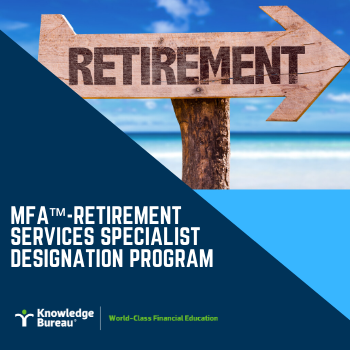Last updated: November 26 2019
Ready for Retirement? Learn Strategies for Doubling Income

Beth Graddon & Walter Harder
The average life expectancy in Canada now sits at 82.1 – a number that’s been steadily on the rise over the years, according to Statistics Canada*. This adds complexity and demand to the financial planning process when both current and upcoming retirees feel that they’re not financially prepared for retirement. In fact, they’re at risk of outliving their savings. What are the strategies financial advisors can use to help?
The challenge. The November 19 2019 Sun Life Barometer outlines how nearly half (47%) of working Canadians believe there is a serious risk they could outlive their retirement savings. The survey also indicates that it isn’t an unjustified fear: 23% of current retirees describe their lifestyle as “frugal” and they follow a strict budget. However, 72% admit their retirement has not turned out as they envisioned, although 65% worked past age 66 out of financial necessity. One of the likely issues? Only 14% had a financial plan prior to retirement.
Currently, working Canadians aren’t handling their financial planning any more effectively than previous generations either. A significant number (44%) indicated that they expect to be employed full-time at the age of 66, and 75% don’t have a financial plan. For younger Canadians, now is the time to start working with a professional who has specialized in this type of planning.
Advisors who wish to do so can learn with Knowledge Bureau by taking the MFA™-Retirement and Succession Services Specialist or RWM™ Designation programs.
The options. For older Canadians like Boomers, who are approaching retirement, there are a couple of strategies advisors can use that may help lead to increased financial security. Knowledge Bureau Master Instructor Walter Harder outlines them with this case study:
Raymond is a single individual who is now 60 years old, earning $75,000 annually who has just recently broken free of family financial obligations. Raymond has no workplace pension and has no retirement savings.
Option 1: Retire at age 65
If Raymond contributes 20% of his income over the next five years to an RRSP, he’ll have accumulated just over $90,000 (assuming 2% indexation and a 5% rate of return). This will yield a retirement income of about $5,900 annually over a 20-year retirement. In addition, he’ll get his OAS of approximately $8,000 annually (current rate indexed by 2% for 5 years) and CPP of about $9,000 (based on the average CPP pension indexed by 2% for 5 years. This yields a total annual income of $22,900.
This leaves Raymond in the low-income category, according to Statistics Canada ($22,133 or a single person in 2018). Likely, Raymond will need to take more from his RRSP/RRIF to makes ends meet and will deplete it during his lifetime, requiring him to sell his home or apply for the Guaranteed Income Supplement.
Option 2: Retire at age 70 while delaying his OAS and CPP pensions
Assuming Raymond can keep his income level at $75,000 (indexed) for the next ten years and contribute 20% of it annually to his RRSP, he’ll have accumulated just over $215,000 in his RRSP. This will yield a retirement income of about $17,400 annually over a 15-year retirement. By delaying his OAS for five years, he will receive an extra 36% or $12,000 annually. By delaying his CPP by five years, he’ll have increased his pension entitlement by continuing to contribute, plus he’ll receive 42% more than he would have had he retired at age 65. Thus, his CPP pension will be about $16,600 annually. This yields a total income of about $46,000 annually.
By working an additional five years and delaying the start of OAS and CPP to age 70, Raymond is able to double his retirement income. This option provides for a livable income for retirement.
Those with lower incomes and no savings will likely have no option but to rely on government support and live at or near the poverty level. Those with some retirement savings will do better but, if they can delay their retirement, the bump in the OAS and CPP rates, as well as any increase in RRSP contributions, will lead to a more livable retirement.
Additional educational resources: Help Canadians feel confident that they’ll live comfortably during retirement, by focusing on increasing the tax-efficiency of their retirement income plans. Enrol in the MFA ™-Retirement and Succession Services Specialist Designation program today.
Enrol online or call 1.866.953.4769 and save an additional $50 on tuition until December 15!
COPYRIGHT OWNED BY KNOWLEDGE BUREAU INC., 2019.
UNAUTHORIZED REPRODUCTION, IN WHOLE OR IN PART, IS PROHIBITED

